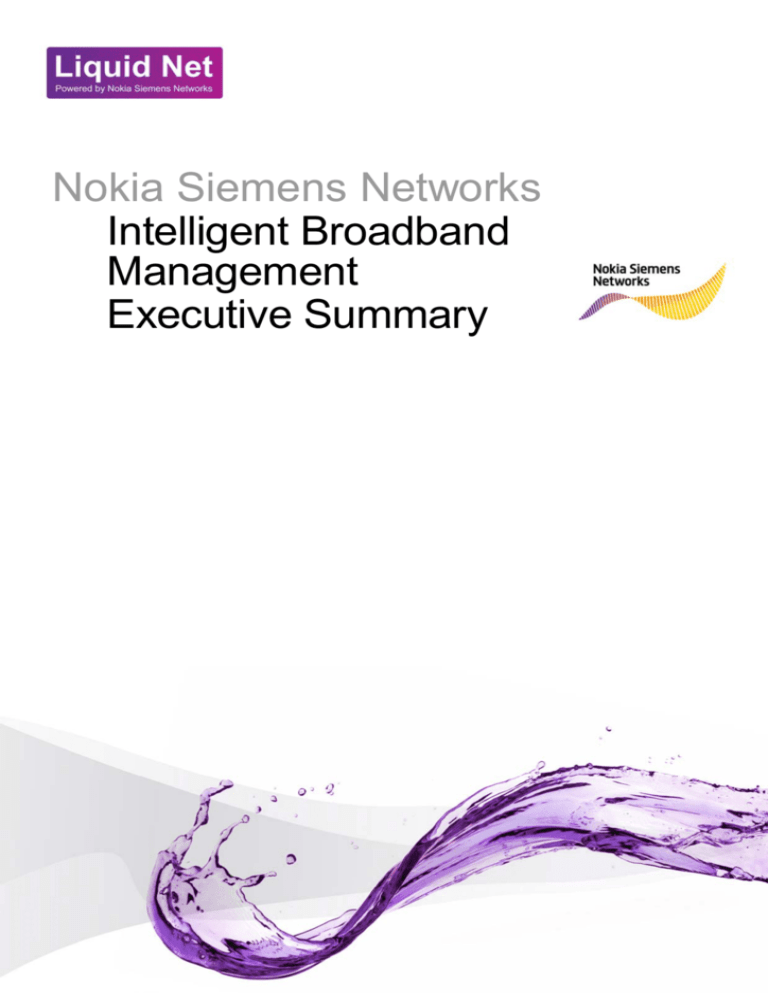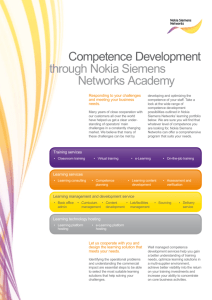
Nokia Siemens Networks
Intelligent Broadband
Management
Executive Summary
2/5
Nokia Siemens Networks
Copyright 2012 Nokia Siemens Networks.
All rights reserved.
End-to-end intelligence efficiently delivers a
superior broadband experience
With exploding broadband traffic volumes presenting new opportunities,
many operators are looking to use network resources as efficiently as
possible to provide a superior, personalized service for their customers. It is
clear that to do this, greater end-to-end intelligence and real-time monitoring
capabilities need to be built into the network.
The key is to make the network continuously aware of user traffic demands,
service needs and the resources available to serve those demands. This
enables the network to recognize where demand is coming from and use
traffic management and content management to adapt itself to cater for
traffic fluctuations
Nokia Siemens Networks Intelligent Broadband Management is at the heart
of our liquid traffic and content management approach. It integrates end-toend applications and functions to optimize the management of traffic and
content in access, transport and core networks, as well as in customer
devices.
Liquid Net
Liquid Net unleashes frozen network capacity into a reservoir of
resources that can flow to fulfill unpredictable demand, wherever
and whenever people use broadband. This is achieved by
intelligent, software-defined network applications running on multipurpose hardware.
The network’s capital efficiency is enhanced. Huge chunks of
unused network resources, as much as 80% of baseband
capacity, are released by avoiding the need to dimension every
network element according to peak demand. In the core domain,
the network element footprint can be reduced by 80% and energy
use by up to 65% as a first step, with further gains possible as
new hardware platforms are adopted.
By smartly tailoring and delivering content using integrated
intelligent solutions that work together seamlessly, Intelligent
Broadband Management enables operators to ensure the best
broadband experience for users wherever they go and whatever
they need, generating customer loyalty and opening up new ways
to create additional revenues.
3/5
Nokia Siemens Networks
Copyright 2012 Nokia Siemens Networks.
All rights reserved.
End-to-end capabilities for the best experience
Many of the network elements charged with traffic and content management
in today’s networks are highly specialized and stand-alone. By integrating
intelligent solutions that work together seamlessly, Intelligent Broadband
Management becomes self-aware and self-adapting, enabling the network
to anticipate user demand and fulfill user expectations dynamically. It
manages traffic efficiently by evolving to end-to-end policy-controlled
network resource allocation and optimized content and service delivery.
Traffic management and content management both promise benefits for
operators, but Intelligent Broadband Management combines them to provide
even greater rewards in terms of efficiency and quality.
Traffic Management
Quality of service (QoS) differentiation is the foundation of effective traffic
management, acting in milliseconds to meet the individual needs of
subscribers. At any given moment, network capacity is distributed to deliver
the throughput and priorities that individual users and/or applications need.
The core network implements policy control to achieve QoS differentiation,
which is then enforced end-to-end, from the core to the radio network and
the customer device.
Today, devices run services that often have different QoS needs within the
same data connection, for example a web browsing session may start a
video stream that needs a higher QoS. Nokia Siemens Networks Intelligent
Broadband Management uniquely offers this capability for HSPA/HSPA+
and LTE.
Deploying QoS differentiation enables operators to prioritize customers and
inspire loyalty. With a choice of service quality levels available, customers
can consider their preferences and the value that each choice brings,
leading to clear expectations that operators can fulfill reliably. For instance,
Nokia Siemens Networks offers a ‘Turbo’ feature that the customer can
select to pay for and enjoy higher data speeds temporarily, raising total
operator revenues by up to 10%.
Content Management
A Content Delivery Network (CDN) allows operators to optimize their
investments in high-quality mobile broadband access, in an improved
customer experience, and in monetizing their capabilities for content rights
holders and service providers.
Web browsing optimization reduces the amount of data sent from the core to
the radio network, freeing capacity to serve more subscribers and delivering
up to four times faster browsing. Video streaming optimization provides
4/5
Nokia Siemens Networks
Copyright 2012 Nokia Siemens Networks.
All rights reserved.
similar network savings and reduces the number of standstills during video
playback by more than 50%.
Content can be cached at several locations so the network can deliver it
faster and with lower latency. Caching also reduces network traffic, because
the content only needs to be delivered once from the provider.
Caching and content optimization make more efficient use of network
resources, helping an operator to handle up to 35% more traffic through
their existing network.
Intelligent Broadband Management
Intelligent Broadband Management is unique because it combines end-toend QoS differentiation with content adaptation, caching and distributed
delivery. Traffic management and content management together create a
more valuable mobile broadband experience while using the minimum
network capacity.
With integrated traffic management, policy control, optimization and content
delivery, Intelligent Broadband Management facilitates fair usage of network
resources. It also ensures operators can build customer loyalty by
differentiating subscribers.
These capabilities allow operators to better map the revenue potential of
their existing customer base by offering tailored packages. And, because
operators control delivery down to the device, they can offer a unique and
valuable service to content rights holders by providing the best possible
customer experience, while also generating revenues from these industry
players.
Integrated traffic management and content management allows an operator
to better manage unpredictable demand using less manpower for a lower
OPEX.
To sum up, with Liquid Net Intelligent Broadband Management, end-to-end
network resources are assigned intelligently and the content adapted to
enable services to be flowed to the user in the most efficient and costeffective way. This achieves fully automated, self-adapting broadband
optimization with best customer experience.
5/5
Nokia Siemens Networks
Copyright 2012 Nokia Siemens Networks.
All rights reserved.
Nokia Siemens Networks
P.O. Box 1
FI-02022 NOKIA SIEMENS NETWORKS
Finland
Visiting address:
Karaportti 3, ESPOO, Finland
Switchboard +358 71 400 4000 (Finland)
Switchboard +49 89 5159 01 (Germany)
Copyright © 2012 Nokia Siemens Networks.
All rights reserved.
Nokia is a registered trademark of Nokia Corporation, Siemens is a registered trademark of
Siemens AG. The wave logo is a trademark of Nokia Siemens Networks Oy. Other company and
product names mentioned in this document may be trademarks of their respective owners, and
they are mentioned for identification purposes only.
This publication is issued to provide information only and is not to form part of any order or
contract. The products and services described herein are subject to availability and change
without notice.








